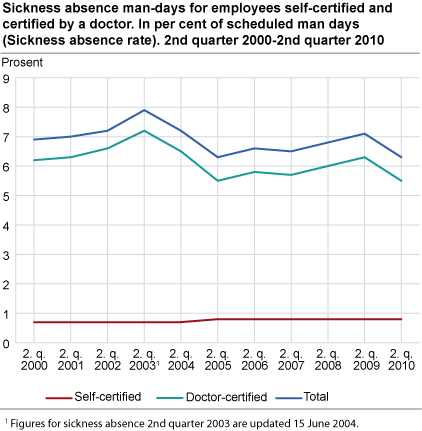Content
Published:
This is an archived release.
Major decrease in doctor-certified sickness absence
Sickness absence fell from 7.1 to 6.3 per cent from the second quarter of 2009 to the second quarter of 2010; a decrease of 10.7 per cent.
Doctor-certified sickness absence fell from 6.3 to 5.5 per cent; a decrease of 12.3 per cent. Self-certified sickness remained unchanged at 0.8 per cent.
Sickness absence for men decreased from 5.7 to 5 per cent, and for women fell from 8.8 to 8 per cent. This equals a percentual drop of 12.2 and 9.5 per cent respectively.
Sickness absence in the second quarter of 2010 was 9.4 per cent lower than in the second quarter of 2001, the year of implementation of the agreement on an inclusive labour market.
Major reduction in construction
All industries showed a decrease in sickness absence from the second quarter of 2009 to the second quarter of 2010. Among the major industries the decline was greatest in the construction industry and the information and communication industry, by 16.9 and 15.3 per cent respectively. Public administration had the smallest decline, by 7.8 per cent.
Private sector had the strongest decrease
Sickness absence in the private sector had the strongest reduction by 11.2 per cent. The absences in central government (including health enterprises) and local government were reduced by 8.2 and 10.7 per cent respectively. [The figures were corrected 21 September 2010 at 1426.]
Within central government, sickness absence in education (universities and university colleges) was reduced by 9.2 per cent, while falling 8.4 per cent in health care (mainly health enterprises). Within local government, there was also a reduction in education (primary and secondary education) by 12.8 per cent, while the sickness absence in health care was reduced by 9.1 per cent.
The sickness absence level was lowest in the private sector and central government, with 6 per cent, and highest in local government, with 7.8 per cent.
Strong decrease in all age groups
Sickness absence fell within all age groups last year. The decrease for both men and women was the strongest among the youngest groups (below 25 years), with 17.5 and 14.5 per cent respectively. [Figures for men and women corrected 7 January 2011]
These results are based on data on sickness absence certified by a doctor, as the survey on self-certified absence does not contain data on sickness absence by age.
Technical informationRates of change The sickness absence rates are presented using one decimal point. More decimal points are used when calculating the rates in order to get more accurate figures. These will therefore differ somewhat from the rates of change produced when using the published rounded figures.
The statistics do not cover self - emplyed persons . |
Tables:
- Table 1 Sickness absence man-days for employees self-certified and certified by a doctor. In per cent of scheduled man-days (sickness absence rate). Quarterly figures. 2000-2010
- Table 2 Sickness absence man-days for employees self-certified and certified by a doctor, by sex. In per cent of scheduled man-days (sickness absence rate). Quarterly figures. 2000-2010
- Table 28 Sickness absence by type of absence (self-certified or doctor-certified) and duration within the quarter
- Table 34 Cases of sickness absence and sickness absence man-days, self-certified and doctor-certified absence, by sex and duration. Per cent. Quarterly figures. 2009-2010
Tables
Contact
-
Arbeidsmarked og lønn
E-mail: arbeidsmarked@ssb.no
-
Unn H. Høydahl
E-mail: unnh.hoydahl@ssb.no
tel.: (+47) 40 90 23 77

